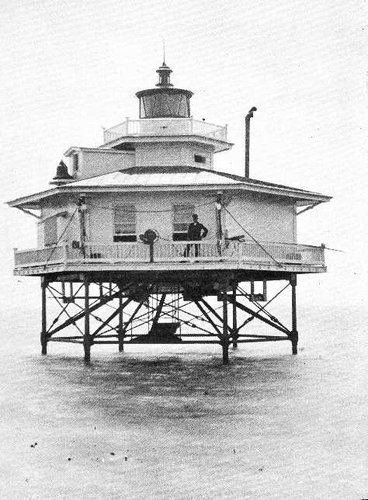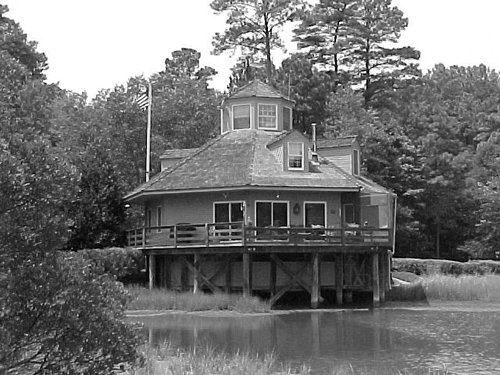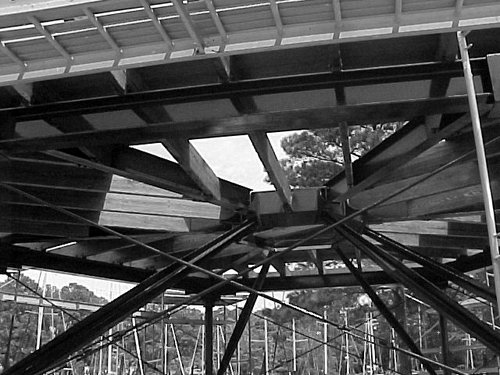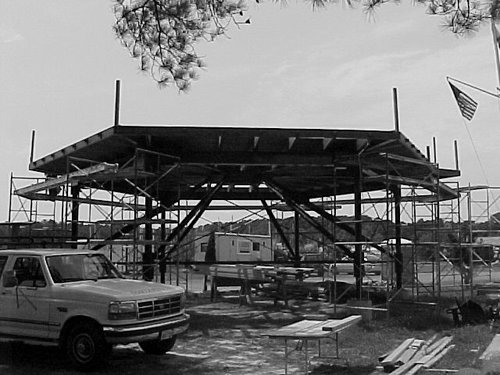by Jere Dennison
 |
| Stingray Point Light in 1885 |
It was sometime during the summer of 1965. Striking out into the Chesapeake from Jacksons Creek during a break between college semesters, something was amiss to the author and his compatriots on a 25-foot wooden Danish sloop. An old familiar landmark....Stingray Point Lighthouse....had vanished. Only a navigation light remained on the old screwpile foundation, dubbed a spider due to its arthropod appearance and its lack of charm. Before then, the light had been perched 34 feet above the water upon the roof of a hexagonal dwelling mounted atop the screwpile foundation. For over 100 years since 1858, the lighthouse had symbolized the Deltaville area with its quaint cottage serving as a familiar landmark for Chesapeake mariners including FBYC sailors.
While the lighthouse conjured up all kinds of images involving wizened lighthouse-keepers living in solitude and tending a kerosene lamp amplified by a 5th order fresnel lens to avert hapless skippers from the shoals off Stingray Point, in reality it had not been manned since 1950. In that year the kerosene lamp had been replaced by an automated electric light and the dwelling was allowed to fall into acute disrepair.
By 1965, the Coast Guard decided that the distressed lighthouse cottage would have to be removed along with many sister lighthouses, such as neighboring Windmill Point Light, which dotted navigational hazards along the shores of the Chesapeake Bay. In those days before the historic preservation movements, it is perhaps not surprising that there were no protests, no mobs in the streets to object to the removal of these historic structures. But what a loss we experienced. Observe the icon status of Thomas Point Light near Annapolis that was saved and has become the undisputed symbol of Marylands northern Chesapeake Bay. Consider the tourist draw of the 1880 Hooper Strait Lighthouse moved to the Chesapeake Bay Maritime Museum in St. Michaels and the 1883 Drum Point Lighthouse moved to the Calvert Marine Museum in Solomons Island.
Virgil Miller, our FBYC Club Manager, has related an interesting, though lamentable, story about the old Stingray Point Lighthouse. The contractor charged with dismantling the structure in 1965 loaded the house intact onto a barge and towed it into Broad Creek. He thereupon offered to give it to Virgil who regretfully declined the offer because he was unable to find space for its placement on the site of his marina. Subsequently the cottage was demolished and the remnants ignominiously trucked away for disposal.

While the old Stingray Point Lighthouse is gone forever, it has surely not been forgotten. We frequently see the old lighthouse as the subject of artwork and advertising in the Deltaville area. And several of our members have endeavored to memorialize the venerable structure in construction projects. Around 1980, Bill and Liz Perkins incorporated the lines of the original lighthouse in the design of their distinctive home on Stingray Point. Their interpretation is certainly reminiscent of the old Stingray Point Light as shown in this recent photograph.
But the most ambitious project yet is the authentic scale reproduction of the original lighthouse by FBYC members Brent Halsey and Jimmy Rogers at their Stingray Harbor Marina. To be completed by early 2003, the contractor is Arthur Wilton, the Club member responsible for building our handsome new clubhouse. Coast Guard drawings and original plans from the National Archives are being used to erect the structure that will be adapted for use as the marina office. The exterior will be accessible for viewing and will no doubt draw many curious onlookers and maritime history aficionados. Recent photos show the fabricated metal supports mimicking the screwpile foundation and the wooden mortise and tendon platform on which the cottage will sit. The original screwpiles and cross bracing to which the current navigation light is still affixed were measured and documented to ensure faithful replication of the correct dimensions.

 |
| The new Stingray Point Light takes shape at Stingray Harbor Marina |
Some of us have nurtured the hope that someday our Stingray Point Lighthouse would be rebuilt on its original screwpile foundation at the mouth of the Rappahannock River. By using modern, synthetic materials, maintenance costs would no longer be an issue. Is this possible, feasible or merely a pipe dream?
Did you know?
Most everybody knows that Stingray Point received its name from Captain John Smith in 1608 when he was speared by the barb of a stingray in this vicinity while exploring the shoreline of the Chesapeake Bay. But others may not know...the Rest of the Story. While in agony from his wound and convinced of its lethality, Captain Smith was transported by his crew to a small tributary on the Northern Neck just north of Windmill Point. There the local Indian population treated him with a medicinal potion that cured his painful affliction. Hence the name of that tributary: Antipoison Creek.